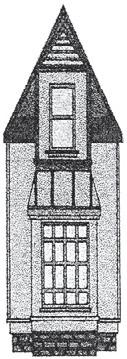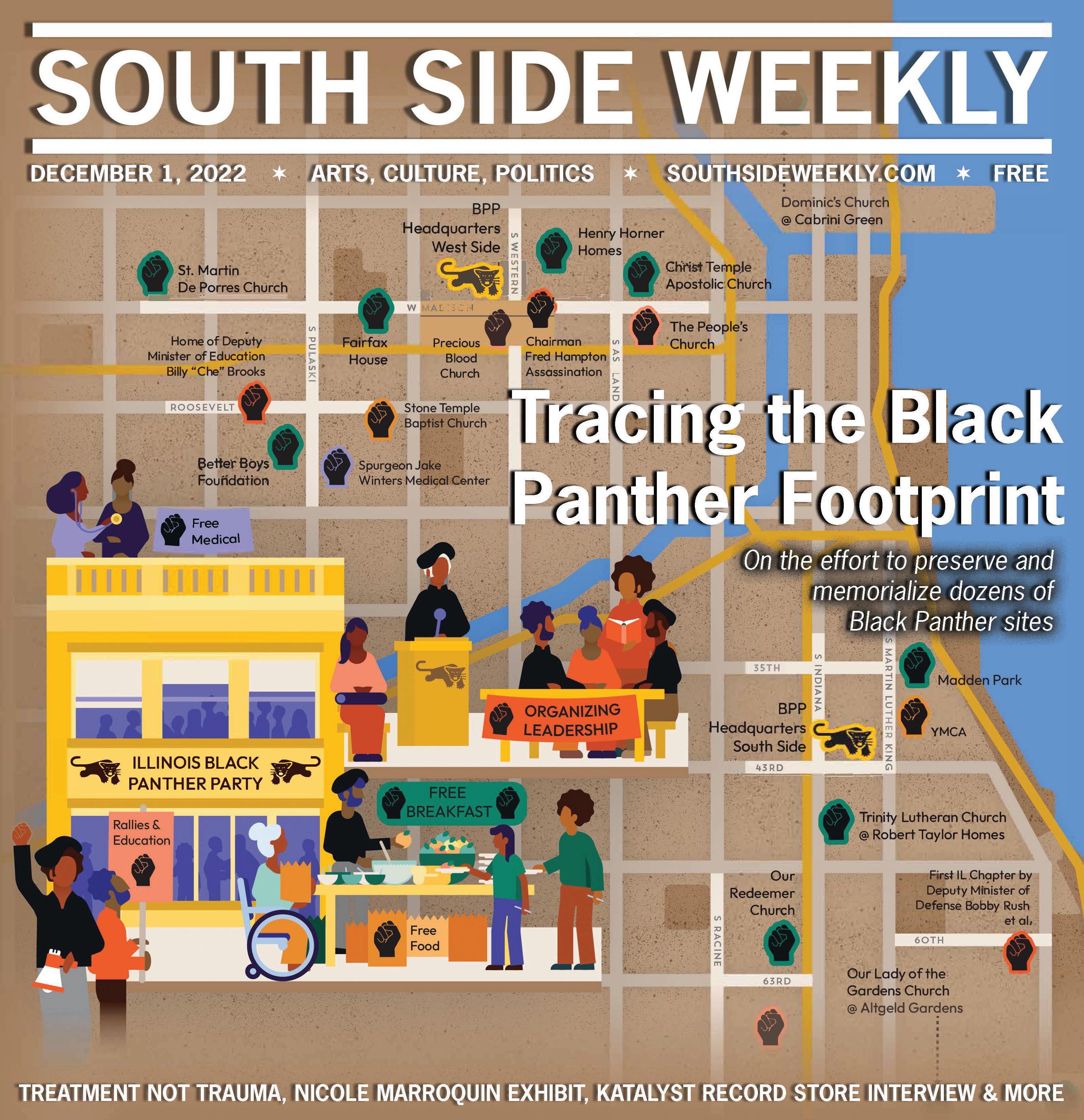




The South Side Weekly is an independent non-profit newspaper by and for the South Side of Chicago. We provide high-quality, critical arts and public interest coverage, and equip and develop journalists, artists, photographers, and mediamakers of all backgrounds.
Volume 10, Issue 6
Editor-in-Chief Jacqueline Serrato
Managing Editor Adam Przybyl
Senior Editors Martha Bayne Christopher Good Olivia Stovicek Sam Stecklow
Immigration Editor Alma Campos
Community Builder Chima Ikoro
Contributing Editors Jocelyn Vega Francisco Ramírez Pinedo Scott Pemberton
Visuals Editor Bridget Killian
Deputy Visuals Editor Shane Tolentino
Staff Illustrators Mell Montezuma Shane Tolentino
Director of Fact Checking: Sky Patterson
Fact Checkers: Grace Del Vecchio Lauren Doan Kate Gallagher Christopher Good Savannah Hugueley Jess Nalupta
Layout Editor Tony Zralka
Special Projects Coordinator Malik Jackson Managing Director Jason Schumer
Office Manager Mary Leonard
Advertising Manager Susan Malone
Webmaster Pat Sier
The Weekly is produced by a mostly all-volunteer editorial staff and seeks contributions from across the city. We publish online weekly and in print every other Thursday.
Send submissions, story ideas, comments, or questions to editor@southsideweekly.com or mail to:
South Side Weekly 6100 S. Blackstone Ave. Chicago, IL 60637
For advertising inquiries, please contact: Susan Malone (773) 358-3129 or email: malone@southsideweekly.com
For general inquiries, please call: (773) 643-8533
In her 2018 election campaign, Lori Lightfoot promised to support efforts to create a graduated real estate tax that would generate revenue to fight homelessness. ‘Bring Chicago Home,’ proposed by the Chicago Coalition for the Homeless in 2018, would create an additional 1.9% tax on sales of homes over $1 million— affecting just 4.2% of properties—and generate $163 million every year to help the estimated 65,000 people experiencing homelessness in the city. Bring Chicago Home is also supported by dozens of organizations, such as Pilsen Alliance, SEIU Health Care, Enlace Chicago, Heartland Alliance, United Working Families, and many more.
Yet Lightfoot has repeatedly shied away from supporting the proposal once gaining office, and last month, she and allies in City Council squashed efforts to add the referendum to the ballot in the municipal elections next February. Prior to a November 14 special meeting of the City Council to vote on whether to add the referendum to the ballot, Lightfoot asked her allies not to attend the meeting; without a quorum, no vote could be held. South Side alderpeople who failed to show up include 3rd Ward’s Pat Dowell, 5th Ward’s Leslie Hairston, 7th Ward’s Greg Mitchell, 9th Ward’s Anthony Beale, 11th Ward’s Nicole Lee, 12th Ward’s George Cardenas, 14th Ward’s Ed Burke, 24th Ward’s Monique Scott, and others.
Supporters of the proposal criticized Lightfoot for going back on her word and not doing enough to address homelessness during her administration. Brandon Johnson, Cook County Commissioner and a progressive mayoral candidate challenging Lightfoot, supports the proposal and said he would focus on housing affordability and public housing if elected. Lightfoot claimed the transfer tax would be risky for Chicago; surely the fact that nearly a third of her campaign contributions last quarter were from real estate groups, who largely oppose the proposal, has nothing to do with it.
The owners of the controversial MAT Asphalt plant in McKinley Park are potential buyers of the Damen Silos located off the I-55 expressway. Friends of the Chicago River, alongside environmental and community groups, sent an open letter to Governor J.B. Pritzker urging the state to halt the sale of the twenty-three-acre site in the South Branch of the River to “a company with a dubious reputation for poor environmental management.” The letter reads, “The riverfront areas surrounding the Damen Silos are already identified for major ecological, public access, and recreational investments that do not align with the concept of the site’s purchaser.” The grain silos were featured in the movie “Transformers: Age of Extinction” in 2014, but aside from that, the silos are no longer in use and the state has an urgency to sell them. Michael Tadin Jr. and his family would be responsible for the environmental cleanup and Tadin Jr. said he would demolish the concrete structures and develop a base for the family’s various businesses.
chicago student uprisings, resurfaced Artist and educator Nicole Marroquin collects and shares archival material.
monica sager ........................................... 4
resurgen las protestas estudiantiles de chicago
La artista y educadora Nicole Marroquín recolecta y comparte materiales históricos de los archivos.
monica sager, jacqueline serrato 5
op ed: referendum results show chicago wants treatment, not trauma
Communities voted to support public mental health centers and crisis responses that don’t involve police.
asha ransby-sporn.................................. 6
court theatre’s gabrielle randle-bent warms to new role
She’s the first Black woman to hold the role of associate artistic director and debuted as solo director with The Island last month. dierdre robinson .................................... 8
tracing the black panther footprint
A non-profit seeks to preserve and memorialize dozens of Black Panther sites. jacqueline serrato 10
Kevin Beauchamp discusses his newest venture, Katalyst Coffee Lounge and Music Gallery. jesus flores 13
The Weekly’s poetry corner offers our thoughts in exchange for yours. chima ikoro, roy “robin” bass 15
A recap of select open meetings at the local, county, and state level.
documenters and scott pemberton 16
calendar Bulletin and events.
zoe pharo, south side weekly staff... 27
illustration by Meg StuderNicole Marroquin, an artist and educator, uses archival material to share the forgotten history of students protesting segregation.
BY MONICA SAGERFrom the early 1960s through the 70s, hundreds of thousands Chicago Public Schools students, parents and teachers from predominantly Black and Latino communities participated in a number of boycotts and walk-outs in protest of school segregation and inequality. These protests, which have largely faded from the public eye today, are the subject of a years-long research effort by Pilsen-based artist and educator, Nicole Marroquin.
“I’m looking at movements led by young Black students,” Marroquin said. “I’m curious about the origins (of different movements), about what led to it, who the solidarities were and where the movements diverged.”
Marroquin, a sculptor, associate professor at the School of the Art Institute of Chicago and a public school art educator has been digging into Chicago’s public school uprisings since 2016. Using this research to create a “skeleton” of what happened in the city in the 60s and 70s, she said she wants to shed light on the systemic inequalities schoolchildren faced across the South and West sides during this time, and the momentum for radical change.
Over the years her art and research has been presented at venues across the city, such as the Hull House Museum, Northwestern University, Chicago Cultural Center and the Museum of Contemporary Art. In 2014, Marroquin was also a Joan Mitchell Fellow at the Center for Racial Justice Innovation.
Much of this project’s research involves collecting newspaper articles from microfilms available at the Harold Washington Library downtown, so as to more closely understand what it was like to be on the ground. In this
process, Marroquin said that she seeks to demythologize the “predigested” stories within American history that many people learn from a young age. As an example, Marroquin pointed to the enduring legend of George Washington cutting down a cherry tree as a child, which did not happen.
In one such example of this underexplored history, Marroquin points to a massive student walk-out in 1963 known as Freedom Day. In protest of school segregation, more than 200,000 students and tens of thousands of teachers—about half the district— boycotted Chicago’s public schools. Many protestors marched around City Hall demanding integration and equitable school funding.
The latest culmination of this research took the form of a gallery Marroquin curated earlier this month in a multi-artist exhibition at the Hyde Park Art Center, “Language Between Worlds.” In her portion of the exhibition, Marroquin assembled dozens of archival photographs and newspaper clippings
documenting these uprisings into a large collage along the art center’s gallery wall. Yellowed headlines like “West Side Makes Demands” and “Black Teachers Caucus” are paired alongside photos of groups of students—some in school, others protesting and a few with teachers.

Marroquin said she takes a relaxed approach to her archival work and is content to “just see what happens” from the information that surfaces during these deep dives. In one such instance, she was surprised to find so many moments of teacher and student solidarity during these protests.
In the process, Marroquin had questions like “How can we forget (this history) so quickly?” and “what impact did the young people make?”
Beyond this inquiry, she is also interested in the relationships that people have with the information she is sharing. Marroquin said she was interested in the “public shared concepts of consciousness around history” and using this work to tell a more complete story about what took place within the city.
Noting that people today are inundated with media, Marroquin said she hopes to cut through the clutter with her art.
“I’m going on these drifts. Imagine a sperm whale—they have those giant filters in their mouths. There’s just like tons of water flowing in and flowing out,” Marroquin siad. “In the same way, that is how we just start absorbing all of this media. It’s just coming at us.”
Marroquin also said she wants to combat what she described as “propaganda” in popular media against participating in events like marches or protests. She said she often sees messages like “don’t march, don’t stand up, don’t take a stand” and argues that this passivity is ineffective in improving conditions for people.
Her next exhibition, an assembly of archival photographs of poetry communities from the late 1970s through the 80s, “Encuentros”, will open at the Poetry Foundation downtown on December 1.
HPAC’s “Language Between Worlds” exhibition, which ended on October 30, featured work from five artists using their craft to explore systemic racial inequalities throughout the U.S. Other artists included Nyame Brown, Jessica Vaughn, Chris Pappan and Bethany Collins. ¬
This story is co-published with the Hyde Park Herald
Monica Sager is a graduate student at Northwestern University’s Medill School of Journalism and has been working to cover health and science within the South Side this fall. They previously wrote about the Love Fridge in Englewood for the Weekly.
Nicole Marroquín, artista y educadora, utiliza materiales de los archivos para compartir la historia olvidada de los estudiantes que protestaron contra la desigualdad.
POR MONICA SAGER TRADUCIDO POR JACQUELINE SERRATOEntre las décadas de 1960 y 1970, cientos de miles de estudiantes, padres y maestros de las Escuelas Públicas de Chicago (CPS, por sus siglas en inglés) de comunidades predominantemente negras y latinas participaron en una serie de boicots y huelgas en protesta de la segregación y desigualdad. Estas protestas, que en gran medida se han desvanecido de la memoria hoy en día son el tema de un esfuerzo de investigación de años por parte de la artista y maestra de Pilsen, Nicole Marroquín.
“Estoy viendo movimientos liderados por jóvenes estudiantes negros”, dijo Marroquín. “Tengo curiosidad sobre los orígenes (de diferentes movimientos), sobre qué los condujo, quiénes estaban en solidaridad y dónde divergieron los movimientos”.
Marroquín, escultora, profesora asociada en la Escuela del Instituto de Arte de Chicago y maestra de arte en escuelas públicas, ha estado investigando los levantamientos en CPS desde 2016. Usando su investigación para crear un "esqueleto" de lo que sucedió en la ciudad en los años 60 y 70, dijo que quiere exponer las desigualdades sistémicas que enfrentaron los estudiantes en los lados sur y oeste durante este tiempo, y lo que los impulsó a exigir un cambio radical.
A lo largo de los años, su arte e investigación se han presentado en lugares de la ciudad, como el Museo Hull House, la Universidad Northwestern, el Centro Cultural de Chicago y el Museo de Arte Contemporáneo. En 2014, Marroquín también fue una becaria Joan Mitchell en el Centro Para La Innovación de Justicia Racial.
Gran parte de la investigación de este proyecto consiste en recopilar artículos
periodísticos de microfilmes disponibles en la Biblioteca Harold Washington del centro, para comprender mejor cómo era estar ahí. En el proceso, Marroquín dijo que busca desmentir varias historias dentro de la historia estadounidense que muchos aprenden desde pequeños. Como ejemplo, Marroquín señaló la leyenda perdurable de George Washington cortando un cerezo cuando era niño, lo que no sucedió.
En uno de esos ejemplos de esta historia poco explorada, Marroquín señala una huelga estudiantil masiva en 1963 conocida como el Día de la Libertad. En protesta de la segregación escolar, más de 200,000 estudiantes y decenas de miles de
estos levantamientos en un montaje a lo largo de la pared de la galería. Titulares desgastados que leen, "El lado oeste hace demandas" y "Caucus de maestros negros", se combinan con fotos de grupos de estudiantes, algunos en la escuela, otros protestando y algunos con sus maestros.
Marroquín dijo que tiene una estrategia relajada en su trabajo de archivo y se contenta con "solo ver qué pasa" a partir de la información que surge durante estas inmersiones profundas. En uno de esos casos, se sorprendió al encontrar tantos momentos de solidaridad entre maestros y estudiantes durante estas protestas.
En el proceso, Marroquín tenía
Marroquín señaló una huelga estudiantil masiva en 1963 conocida como el Día de la Libertad. En protesta de la segregación escolar, más de 200,000 estudiantes y decenas de miles de maestros, aproximadamente la mitad del distrito, boicotearon las Escuelas Públicas de Chicago.
maestros, aproximadamente la mitad del distrito, boicotearon las Escuelas Públicas de Chicago. Muchos manifestantes marcharon alrededor del Ayuntamiento exigiendo integración y financiamiento escolar equitativo.
La última culminación de esta investigación tomó forma en una galería curada por Marroquín a principios de este mes como parte de una exposición de varios artistas en el Hyde Park Art Center, “Language Between Worlds”. En su parte de la exposición, Marroquín reunió docenas de fotografías de archivo y recortes de periódicos que documentan
preguntas tales como "¿Cómo pudimos olvidar (esta historia) tan rápido?" y “¿qué impacto tuvieron los jóvenes?”
Más allá de esta indagación, también le interesan las relaciones que tienen las personas con la información que ella comparte. Marroquín dijo que estaba interesada en los “conceptos públicos de conciencia en torno a la historia” y en usar este trabajo para contar una historia más completa sobre lo que sucedió en la ciudad en esa época.
Al señalar que la gente hoy en día está inundada de medios de comunicación, Marroquín dijo que espera eliminar el
caos con su arte.
“Me dejo llevar. Imagina una ballena: tienen esos filtros gigantes en la boca. Hay como toneladas de agua entrando y saliendo”, dijo Marroquín. “De la misma manera, así es como comenzamos a absorber todos estos medios. Simplemente nos llegan”.
Marroquín también dijo que quiere combatir lo que describió como “propaganda” en los medios contra la participación en marchas o protestas. Dijo que seguido ve mensajes de “no marchen, no protesten, no tomen una postura” y argumenta que esta pasividad es ineficaz para mejorar las condiciones de vida de las personas.
Su próxima exposición, un conjunto de fotografías de archivo de comunidades que hacen poesía desde finales de la década de 1970 y la década de 1980, “Encuentros”, se inaugurará en la Poetry Foundation del centro el 1 de diciembre.
La exhibición "Language Between Worlds" de HPAC, que finalizó el 30 de octubre, presentó el trabajo de cinco artistas que usaron su oficio para explorar las desigualdades raciales sistémicas en los EE.UU. Otros artistas incluyeron a Nyame Brown, Jessica Vaughn, Chris Pappan y Bethany Collins. ¬
Esta nota fue publicada conjuntamente con el Hyde Park Herald.
Monica Sager es estudiante de posgrado en la Escuela de Periodismo Medill de la Universidad Northwestern y ha estado trabajando este otoño para cubrir la salud y la ciencia en el lado sur. Previamente escribió sobre un refrigerador público en Englewood para el Weekly
This story was first published by the Chicago Reader on November 18. Reprinted with permission.
In this November’s midterm, Chicagoans in three wards encompassing neighborhoods from Auburn Gresham to Albany Park voted overwhelmingly in support of a referendum asking if the city should reopen its closed public mental health centers in support of a crisis response system that would not involve police. The decisive public mandate was years in the making.
I remember being home for the holiday break from my senior year of college and sitting at my mom’s kitchen table when we read the news about Quintonio LeGrier and Bettie Jones in December 2015. Quintonio was a nineteen-year-old college student, not much younger than I was at the time, also home from college for the holiday break. The morning after Christmas, Quintonio called 911 for help three times. He pleaded with the operator to send the police before being dismissed and ultimately hung up on. Then his father called explaining that his son had “freaked out” and was holding a baseball bat. As the LeGrier family navigated what to do, Quintonio experienced an intensifying mental health crisis.
The family tried to seek help, but was eventually met by police officers who arrived at their door with guns drawn. Neighbor, community activist, and mother Bettie Jones opened the door for officers, presumably with the intent of preventing a
police interaction from escalating. Within minutes, CPD officer Robert Rialmo shot Jones once and LeGrier six times, killing both of them. Police documents later acknowledged that proper medical care to try to revive them was not delivered after either victim had been shot.
What the LeGrier family reached out for was support finding care and someone to help de-escalate their son’s mental health crisis. What officers delivered was a violent response resulting in two tragic losses.
LeGrier’s story is unfortunately not rare. Policing and other approaches to
mental health that meet people in need of care with force or punishment often have incredibly harmful consequences and exacerbate problems. In addition to the alarming rates at which police kill people with mental illness, law enforcement interactions with those in crisis commonly result in a person being injured, incarcerated, or enduring further psychological distress.

This year, hundreds of volunteers signed up to knock on doors, make phone calls, translate campaign materials, help with data entry, distribute yard signs, and more. Going door-to-door on the hottest
days of August and the coldest of October, we heard from longtime residents who remembered the closed mental health centers in their neighborhood, who knew people who relied on them, who remembered when community fought their closure, and who still believe we deserve mental health centers that are public and accessible to all. We heard from people with a range of experiences how deeply felt the reality of not having someone to call or a place to go in a moment or time of crisis really is.
One Back of the Yards family spoke about calling 911 for help getting care for a loved one who was having a mental health episode during a gap in access to needed medical care for both their diabetes and mental health. They were then arrested and ended up spending a year in Cook County Jail instead of receiving the medical attention they were looking for.
On election night, surrounded by a few dozen volunteers tired from a long day of talking to voters, we started refreshing the Board of Elections website as soon as the polls closed. We had spent the better part of the last six months having thousands of variations of the same conversation that built on over a decade of organizing to reopen the mental health centers and a parallel decade of organizing around the city’s bloated police budget: Would you like to see the City invest more in mental health? Do you support mental health workers instead of police officers responding to mental health crises? Have you lived in the neighborhood long enough to remember the clinic on Woodlawn? Would you like
to see the city to reopen the mental health centers they closed down?

The referendum results finally came in at more than ninety percent favoring Treatment Not Trauma (TNT), a model for public mental health infrastructure that would include city-run mental health centers and a 24-hour crisis response hotline that would dispatch mental health workers instead of police officers. A concrete proposal by, for, and supported by community, Treatment Not Trauma was envisioned by a coalition of people with mental illnesses, care workers, researchers, and community members with the Collaborative for Community Wellness (CCW), and was introduced to city council by Alderwoman Rossanna RodriguezSanchez in 2020.
There are hundreds of thousands of people with mental illness behind bars in the U.S. In almost every state, jails or prisons claim to treat more people struggling with mental illness than hospitals do. In the current landscape, there are far too many ways people in need end

up criminalized and further traumatized and never accessing quality care.
Chicago’s current void of public mental health infrastructure should be understood in the context of how neoliberal reform has manifested locally. Cutting funding for or privatizing public programs and institutions like clinics or schools is part of how political leaders pull the rug out from under working class communities and leave us all more vulnerable to crisis. Steadily increasing funding for police while just about everything else is on the chopping block contributes to the reality that policing and criminal punishment are the default responses to social problems that might better be handled with care or a preventative approach that gets at root causes.
The powerful display of public opinion reflected by the referendum results came ten years after former mayor Rahm Emanuel shut down half the city’s remaining mental health clinics in a supposed move to save a mere $3 million. In the mid-1990s, there were nineteen city-run mental health
clinics. By 2012, there were twelve.

Today there are only five. Analyzing behavioral-health related 911 calls by ward and neighborhood, CCW published a report this year that shows that some of the highest concentrations of mental health crisis calls are in the parts of the city where clinics were shut down. These tend to be Black and Brown neighborhoods impacted by other forms of ongoing divestment that have a negative impact on the mental health, stability, and overall well being of communities. What CCW’s research highlights is that one impact of the closure and absence of mental health facilities is that more escalated crises arise where they could have been avoided if there were access to consistent care and other forms of support. CCW’s report reads, “[w]ith the decimation of the public safety net . . .mental health needs often go unaddressed until they reach a point of crisis.”
The campaign for Treatment Not Trauma is as much about crisis response as it is about being part of a robust network of

public institutions, systems, and programs Chicagoans could rely on for care in order to prevent as many crises from occurring. It’s a vision for creating mental health centers that could play an even larger role than the clinics that once existed.




Public mental health infrastructure in Chicago, as outlined by TNT advocates, would include mental health centers that offer more holistic forms of care that certainly don’t involve police or incarceration, but also that don’t overly rely on medication or hospitalization. It would provide accessible therapy and support finding housing and getting other needs met. It would offer peer support teams and resources for loved ones to be supported in playing a role in caring for the people in their lives who need it. It would be traumainformed and not one-size-fits-all.
Building on Emanuel’s legacy, Mayor Lori Lightfoot has doubled down on an approach to mental health that relies on private providers and police involvement while failing to invest in public institutions. When she ran for office, Lightfoot
promised to reopen the clinics “and more”—but quickly backtracked. Private clinics, which are the basis of Lightfoot’s insufficient approach, have simply been unable to meet the scale of need that exists in the way a public system could. That’s not to mention how private facilities tend to underpay and under-resource providers who are then left without what they need to offer quality care.
Chicago communities most impacted by the compounding crises of mental health, policing, divestment, and other forms of structural violence have made our voices loud and clear on this issue for years. When Mayor Richard M. Daley first tried to shut down some of the city’s
precincts that have the highest concentration of mental health crisis calls to 911 in the whole city. Sixth Ward alderperson, Roderick Sawyer, who chairs the Health and Human Relations Committee, has failed to schedule a committee hearing on Rodriguez-Sanchez’s Treatment Not Trauma ordinance since she introduced it in 2020. (Sawyer did schedule a hearing in March 2021 on the City’s existing CARE pilot program, which sends mental health professionals alongside police, but not on the TNT ordinance itself.) Residents of the 6th Ward voted in favor of the referendum by ninety-eight percent.
And in the 33rd Ward on the city’s northwest side, home of TNT champion
mental health clinics, community forces came together in protest and were able to effectively stop him. During Emanuel’s time, a movement made up of patients, mental health providers, and community members fought hard to keep clinics open. They persistently and powerfully organized community forums, confronted the mayor at his house, engaged in civil disobedience, and other forms of protest.
Now, a movement of Chicagoans has again shown that we are backed by the opinions of thousands in calling for Treatment Not Trauma. In the 20th Ward, where community members actually occupied and camped outside of the Woodlawn Mental Health Clinic for a whole summer before its ultimate closure in 2012, this year’s referendum passed by ninety-six percent.
The South Side’s 6th Ward includes
Rodriguez-Sanchez, it passed with ninetytwo percent support.
Our communities have voiced a clear desire for a solution that is both incredibly commonsense and wholly different from what we have now. With consensus from communities across the city, Chicago political leaders and hopefuls should take action by getting behind funding and implementing Treatment Not Trauma. And we should see that as one important element of a broader set of needed investments and policies that take responsibility for making and keeping the city truly livable for its Black, Brown and working-class residents. ¬
Asha Ransby-Sporn is a community organizer who served as the field director on the Treatment Not Trauma referendum effort in the 20th Ward.
In July 2022, scholar, artist, and educator Gabrielle Randle-Bent was appointed as associate artistic director at the University of Chicago’s Court Theatre. The thirty-something Arlington, Texas native is the first female and African-American woman to hold the title.
The role of associate artistic director “is a very specific type of position because we were looking for someone who is both a brilliant artist and a brilliant scholar,” said Executive Director Angel Ysaguirre. “So, we were looking for a very different type of person. We wanted someone who could thrive at the university as a scholar and thrive within the theater community as an artist and who also was very sensitive to how a theater engages community members.”
Randle-Bent holds a BA in Drama & Sociology from Stanford University, an MA in Performance as Public Practice from the University of Texas at Austin and is a PhD candidate at Northwestern University. She is also a senior lecturer in the Theater and Performance Studies
program at the University of Chicago.
“The theater is led by two people,” said Ysaguirre. “So, it’s led by me on the administrative and strategic side and then led by Charlie Newell on the artistic side. And while Gabby’s position is in the arts…a lot of what she does also overlaps with strategy and administration. So, we’re going through strategic planning process right now at the theater and one of the things that we’re really deeply considering is how does Court Theatre’s work integrate more meaningfully into the curriculum of the university.”
Randle-Bent is no stranger to Court Theatre. Her career with the Tony Awardwinning theater began in 2019 when she served as the inaugural Court Theatre Research Fellow. One of Randle-Bent’s responsibilities during her fellowship was to serve as dramaturg for Court’s productions of Guess Who’s Coming to Dinner, Oedipus Rex and For Colored Girls Who Have Considered Suicide/ When the Rainbow is Enuf.
So, what is a dramaturg? To put it simply, “a playwright and a director are
The Texas native is the first Black woman to hold the role of associate artistic director at the theater and debuted as solo director with The Island last month.
The campaign for Treatment Not Trauma is as much about crisis response as it is about being part of a robust network of public institutions, systems, and programs Chicagoans could rely on for care in order to prevent as many crises from occurring.
my thirteenth birthday, my parents took me to New York and we got half priced seats to see Aida and Toni Braxton happened to be in it at the time. I was on row 8A and I was so close I could see the microphones. I could see the wings and I could see the light grid. It was magical.”
High school and college years brought more opportunities for Randle-Bent to experience that theatrical “magic”—only
relationship.”
With her new appointment, RandleBent also made her solo directorial debut with the November 11 opening of The Island.

The play, written by Athol Fugard, John Kani and Winston Ntshona, centers around a pair of political prisoners on South Africa’s infamous Robben Island, who spend their days toiling mindlessly
a high level of care around arguably controversial topics such as incarceration, apartheid and racism.
“What was thrilling about this play was with the text, like literally with the words,” Randle-Bent said. “We had this blank canvas where we could use the words and also the original process. So, not make a play that was built on the foundations of apartheid-era South Africa…but a play that was really grounded in that history that helped us think through questions of things we’re struggling with in this moment.”
“As a Texan, I am painfully aware [that] I won’t be a Chicagoan, maybe ever,” said Randle-Bent. “But what that means to learn to love this place and to do that in this role—and also get to learn—I feel like, is just unreal. I feel so lucky.”
like an architect team,” Randle-Bent said. “They imagine something amazing, stunning…something that no one has ever done before. And a dramaturg, in a lot of ways, is like a structural engineer. They come in and they say, ‘this wall needs to be load bearing. Or, I noticed this house is two stories but it doesn’t have stairs.’”
In addition to being a dramaturg during her fellowship year, Randle-Bent also co-founded the Civic Actor’s Studio, a leadership program of the University of Chicago’s Office of Civic Engagement.
But Randle-Bent admits that theater was not an initial interest of hers growing up.
“In high school, I was very much like [an] athlete and I took AP math and science courses,” she said. “That really was like in terms of what I felt like what I was choosing for myself.. like defined me. I thought I wanted to be an engineer. Well, I wanted to be an engineer and like in just sort of haphazard ways.”
Perhaps due in part to the influence of her middle school friends who were involved in theater or her own experience as a young theater goer, Randle-Bent’s passion for the theater soon began to blossom.
“I was obsessed with Annie and the Lion King,” Randle-Bent said. “And for
this time, firsthand. Before long, she was directing her high school spring musical and by college, she was taking on roles such as stage manager for a Winter One Acts production after seeing an ad in the bathroom of her college dormitory. One theatrical leadership role led into yet another.
“I just started spending more time in the theater department than I did anywhere else,” said Randle-Bent. “And I just have always felt at home…and just never felt more at home than when I’m in a dark theater. Sitting looking up at the stage. So, yeah, in a lot of ways, it chose me.”
As Court’s associate artistic director, Randle-Bent’s has already begun to apply her vast amount of expertise in her new role with an emphasis on new play development and community engagement.
“The thing that she’s really leading is our new play development process,” said Ysaguirre. “Gabby also brings an incredible level of sensitivity to how the work that we do impacts communities and how we might be in relationships with communities so that we’re responding to what they want as much as we’re offering them something that we think we have to offer. So, to be in a true two-way
while secretly rehearsing a two-man version of Sophocles’s Antigone at night.
Randle-Bent’s challenge as director was to bring the playwright’s words and vision to life for the audience in the most meaningful ways while maintaining
The Island runs through December 4. Court’s remaining season will include the play Fen, which opens in February of 2023. For more information about Court Theatre, The Island and upcoming plays, visit www.courttheatre.org. ¬
Dierdre Robinson is a writer and accounting manager in Chicago. Her last piece for the
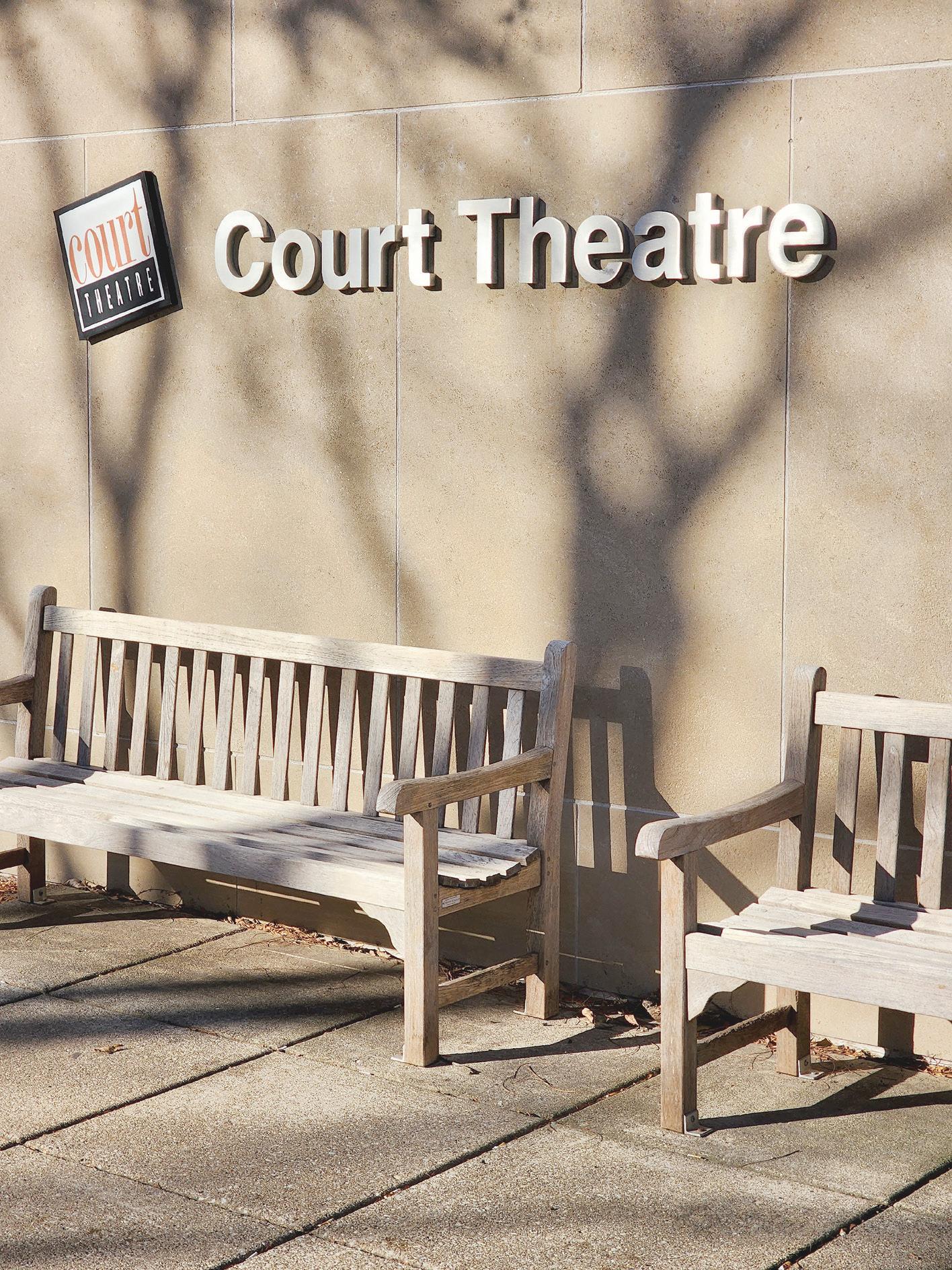
“A playwright and a director are like an architect team. They imagine something amazing, stunning…something that no one has ever done before. And, a dramaturg, in a lot of ways, is like a structural engineer. They come in and they say, ‘this wall needs to be load bearing.’” –Gabrielle Randle-Bent
Gabrielle Randle-Bent. PHOTO COURTESY OF COURT THEATERPHOTO COURTESY OF COURT THEATRE
Despite the Black Panther Party’s (BPP) nationwide prominence in the political discourse of the 60’s and 70’s, the Panthers’ vast reach and lasting impact has not been sufficiently documented and recognized in Chicago and Illinois. According to local historians, the network of the Chicago-area Panthers—where deputy chairman of the Illinois chapter and national spokesman Fred Hampton was from—is poorly understood largely because the sites of BPP activity have not been preserved, memorialized, or taught as a legitimate part of Chicago history.

The majority of Illinois Panther sites have been demolished or redeveloped and were never given any markers of historical recognition. The Panthers’ main headquarters, for example, located at 2350 W. Madison, is now a Walgreens. The apartment where Hampton and defense captain Mark Clark were killed by Chicago Police was torn down and replaced with another residence bearing the same address. Dozens of Black Panther-led free breakfast program distribution centers and free medical clinics are absent from the historical record.
“The party, to me, has been the victim of a fifty-year smear campaign,” said Leila Wills, co-founder and the executive director of the Historical Preservation Society of the Illinois Chapter of the Black Panther Party, beginning with the government surveillance of and attacks on the Panthers under the FBI program COINTELPRO.
The recently formed non-profit is
A non-profit is working to preserve and memorialize dozens of Black Panther sites, like free breakfast programs, medical clinics, headquarters, and more.
working to correct the narrative by seeking national landmark recognition of a list of more than eighty sites and properties across the state where the Illinois Black Panthers actively organized between 1968 and 1974.
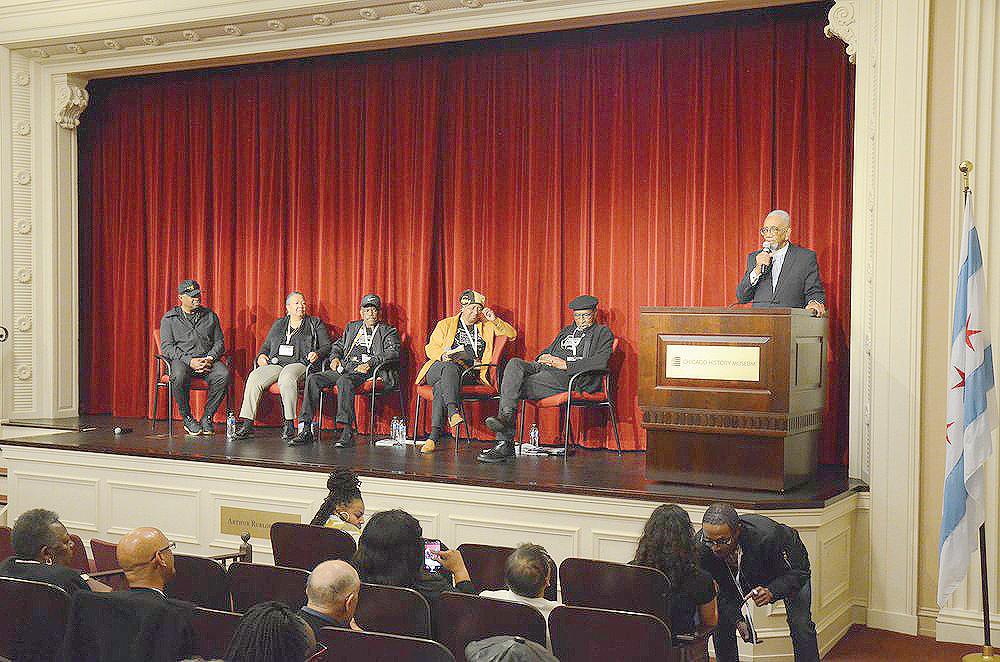
The list includes the locations where Hampton was killed and his funeral was held, the BPP headquarters and offices, where police raids and shootings took place, and about thirty sites of the Free Breakfast for Children program. “It just became this urgent situation where gentrification is ongoing, that what we stand to lose will be wiped from the city’s history physically, so we don’t want that to happen. And that’s how it started,” Wills said.
Wills grew up knowing that her parents were BPP members in Altgeld Gardens on the South Side. They worked in the breakfast program, at a medical center, and sold newspapers. But by the time she was coming up, “The party didn’t exist anymore, so I can’t really remember them,” she said. “They would just kind of come up [in conversation], especially if we were in the car, my father would say, ‘Yeah, we used to have an office right here’... and
so it was there in my head.”
BPP members like John Preston and Wanda Ross are helping Wills to contextualize the significance of some of the sites, she said. Billy “Che” Brooks, co-
founder of the Historical Preservation Society and the Deputy Minister of Education for the Illinois chapter, is helping the Historical Preservation Society launch a public awareness campaign to
inform the community about the legacy of the chapter and their presence in multiple neighborhoods.

Wills was previously involved in the fundraising efforts to save the Hampton house, led by Fred Hampton Jr. out of his father’s Maywood home, which obtained local landmark recognition in April of this year and will eventually become a fullfledged museum and community center. “That was for the single property, but I still wanted to tell the story of the Illinois chapter by locations because when you start breaking down their locations, each has a significant story with it,” Wills said. “Plus, it just showed how extensive their work was even not including people like the Young Lords and others in the Rainbow Coalition.”
The State Historic Preservation Office is helping the non-profit fill out the necessary paperwork for multiple properties, which they will present to the Springfield office in February 2023 for consideration in the National Register of Historic Places. “We’re starting at the state level,” said Willis, “and then we’re going to






be pursuing some landmark status at the city level. Now that’s where I anticipate [opposition], hopefully I’m wrong and that people are ready for this kind of discussion.”
Their current proposal needs to highlight one property from the list of BPP sites. The People’s Church, located at 201 S. Ashland, is already a Chicago landmark under the name Epiphany Center for the Arts. “That was a significant party location,
organization plans to get plaques installed at the sites. For structures that are already landmarks, such as the church, they are working to amend their listings to include the history of the Illinois Chapter.
In October, the Historical Preservation Society held an event at the Chicago History Museum for surviving Black Panthers; it was hosted by Chuck D from Public Enemy, and featured special guest and Illinois chapter founding Panther, retiring Congressman Bobby Rush. Young people from Free Spirit Media were some of the most enthusiastic participants, asking most of the questions during a Q&A session after a panel discussion.
“I wanted to do an event in honor of the Illinois chapter and simultaneously begin a public awareness campaign of the landmarking effort that we were doing. It was really my own personal dream to do an event at the Chicago History Museum in honor of the Illinois chapter. And I wanted the Chicago History Museum specifically because that’s what level of conversation the Illinois chapter needs to be on,” Wills said.
The event received support from the Chicago Community Trust, the Center for the Study of Race, Politics, and Culture at the University of Chicago, and St. Sabina Church, among others. A “part 2” event is
and we are in touch with the people who own it now and, you know, they’re supportive of it,” Wills said. “That was their main meeting place, that was one of the last places Chairman spoke before he was assassinated. That’s where, if you find news articles and you know anything happened, that’s where it happened.”
For structures that no longer exist, the
in the works for December 15 at NEIU’s Jacob H. Carruthers Center for Inner City Studies, 700 East Oakwood Boulevard. Registration is free online at ilbpp.org/ events ¬
Jacqueline Serrato is the Weekly’s editorin-chief.
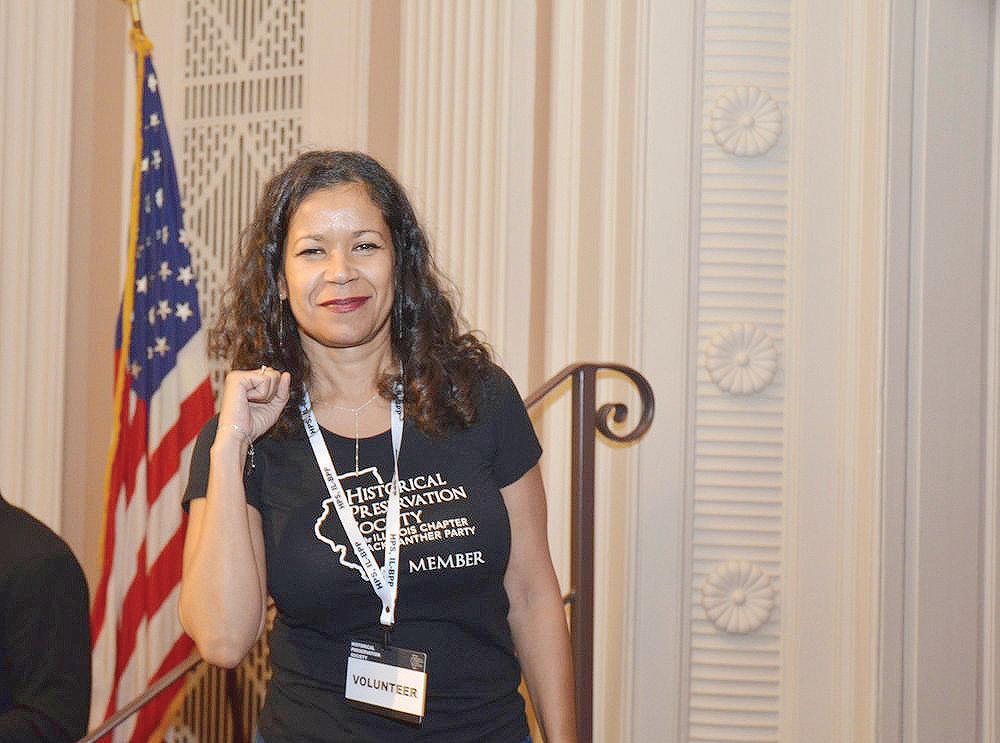
“I still wanted to tell the story of the Illinois chapter by locations because when you start breaking down their locations, each has a significant story with it. Plus, it just showed how extensive their work was.”
–Leila WillsLeila Wills COURTESY OF THE HISTORICAL PRESERVATION SOCIETY OF THE ILLINOIS CHAPTER OF THE BLACK PANTHER PARTY
Kevin Beauchamp, the owner of Katalyst Coffee Lounge and Music Gallery, is an avid music fan and record collector. “It might be the old-school nature I come from,” he says. “I’m used to pressing up some CDs and hustling to sell ‘em … something about that, physically holding the music, it connects with the experience.”
He’s a veteran of Chicago’s house music scene, having spent countless hours DJing around the city during high school. This experience inspired Beauchamp to pursue his love of music, and led to a career working for record companies on the West Coast. Eventually, Beauchamp left PolyGram to start his own label, Katalyst Entertainment, which has published releases by Chicago icons like Kahil El'Zabar, Phil Cohran, and the Art Ensemble of Chicago.
Today, Beauchamp runs his café and record store in Hegewisch on the Southeast Side. Now in his early fifties, Mr. Beauchamp wants to share his records and stories with the world through his store.
This interview has been edited for length and clarity.
Why do you think there’s been such a resurgence in demand for analog music mediums, like vinyl and cassettes?
It’s just a warmer, more human feel, I guess. You know, I’m a physical person. I think that music is a tool, you know, or a resource, a raw material for social interaction from person to person. And I think that’s where it lives most effectively. You know, I really want young people to get into having some physical interaction, man. I know with the pandemic, all that
isolation is an effort to limit the spread [of COVID-19], but I think that we gotta keep our humanity somewhere. So you know, virtual is all fine and dandy, but I don’t think that’s really living, you know.
Why did you decide to name your record store and label Katalyst? Is there any philosophy behind the name?
The idea was about what a catalyst is, right. It’s something that creates a change without changing itself, you know, a spark. It was about building something
know? So when I got into high school, I found that the house music scene was kind of rekindling a lot of old cuts that I had already gravitated to.
Post-high school, I went to college down in Champagne. At that time, my mother moved back to California, so I went out there to study broadcasting. That led me to an internship at A&M records out in LA. So I worked at A&M for a time, and then I got offered a job with PolyGram Records.
Besides being a record store, Katalyst is also your record label. How did that
years younger than the next younger person, and was like: I’m not going to wait around ten years. I was young enough to take some risks. I decided I would leave and start my own label.
What did you do besides working on your label after you left PolyGram?
I don’t know if you know who The Art Ensemble of Chicago is; they’re kind of the flagship group of the avant-garde jazz movement. I grew up with that influence around— I went to a concert of theirs, which captivated me, when I was about eleven or twelve. And later, after I left PolyGram,I had the opportunity to go on the road with them. A couple of months later, I’m over in Europe. At first I was a roadie, but I became their manager and tour manager, all the while producing for my label.
here in Chicago, music industry-wise. Because in the past labels were plucking talent out of Chicago.
Before you started working on the Katalyst store, what was your history with music, personally and professionally?
I was a DJ in high school, and always had a collection of music. My father was a singer, my stepfather was a blues singer, and my mother was a collector. I always had a lot of music, a lot of records, and a lot of just listening to everything, you
come about? What made you want to work independently?
So I started getting into the music industry, and once I got working for major labels and distribution and all, I was kinda where I wanted to be. I wanted to get into the creative end. I wanted to get into the A&R department.
I had a lot of friends that were into the hip-hop movement in the late eighties, early nineties, so I started producing records with them. And [at the same time], after a few years with PolyGram, I was facing a big wall to get to the creative side. I was ten
I’ll tell you, the first show we did… just seeing it live, a whole new wing of understanding opened up to me. The first solo Roscoe Mitchell took…I’d seen the rehearsal, and I was like—okay, you know, whatever. But when it was real-time, and it was live, he took off. And then it was like: I get it.
I know you have a long history of working behind the scenes, but what made you want to start a record store here?
I went down to Kansas City for a couple of years. I got hooked up with a contractor who got the contract to redo the jazz district, and I was going to have my store there. However, my children came back
“I think that the way we consume music affects us, right?”
–Kevin Beauchamp
move back to Chicago, and then I started looking for buildings to create this vision I already had established. So I bought the building and have been working on it here and there. I got hooked up with the business association. So finally, I just got to the point where I said: I have to open.
What was your breakout project, or an artist you were incredibly excited to work with?
I met Phil Cohran, and I ended up putting out some recordings, some reissues and unreleased stuff with him. That kind of put my label on the map. I got my distribution deal. After that, people started coming out of the woodwork, wondering how I got to release Phil Cohran’s material. And it was pretty amazing to me as well, because I had gotten a hold of the recording called The Malcolm X Memorial and put that out. Phil Cohran passed on a couple of years ago, but he’s still probably the most under-talked-about influence in Chicago music that you can think of.
The whole streaming thing, while it’s convenient and the newer generations have adapted to that, I think that the way we consume music affects us, right? Take albums in particular, the way we react to them—not only sonically, there’s a physiological thing that happens [in response] to the wavelengths and stuff like that. Now that’s a little bit deep for me. Phil Cohran could probably explain it! I’ve always been a vinyl person, personally. I mean, I have a lot of CDs too, but when everybody was transferring over, I stuck with my vinyl. I always liked to play my vinyl instead of CDs or tapes.
You’ve mentioned hosting live music at Katalyst and how it builds a communal space for music listing. Do you think your time as a house music DJ plays into that?
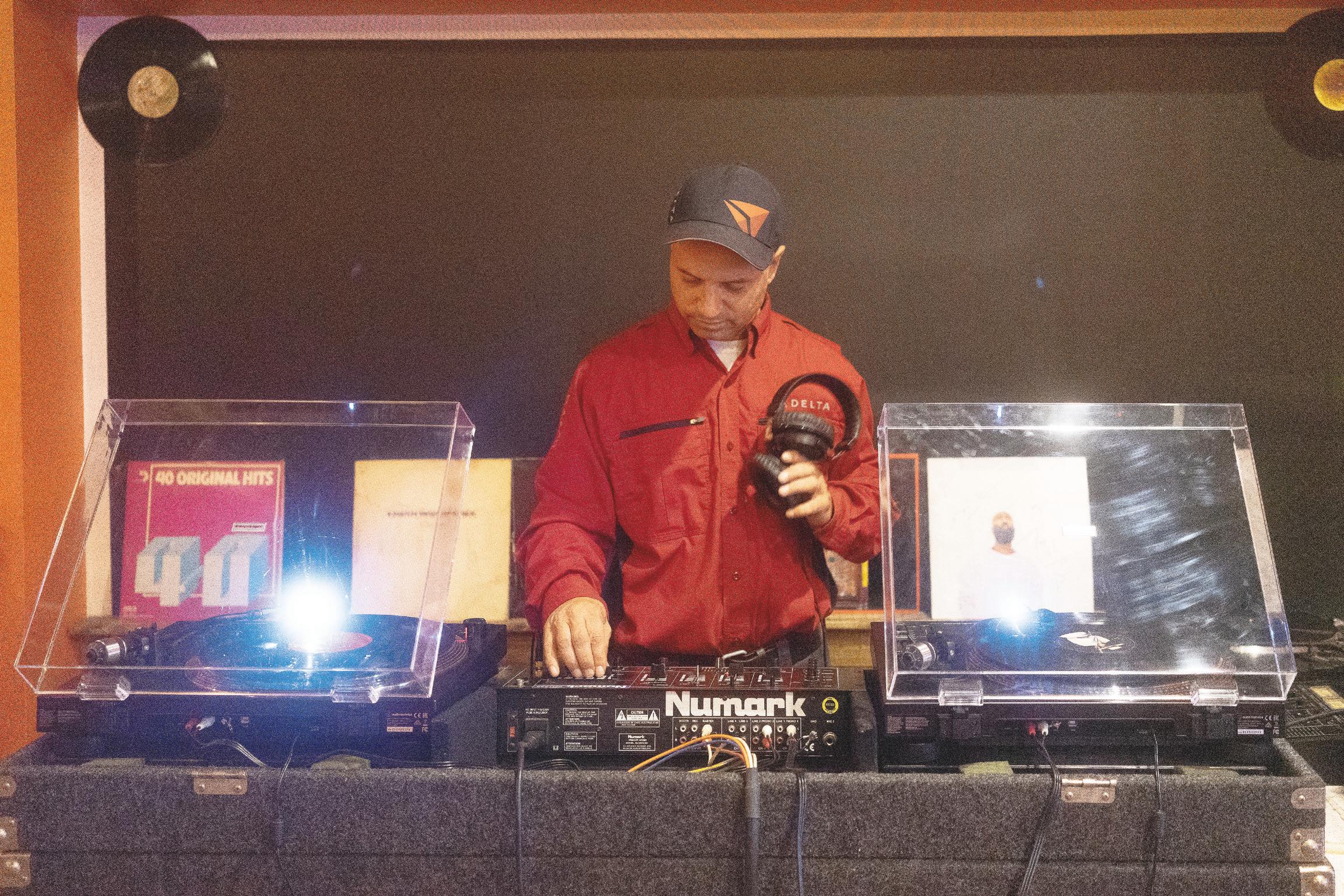
Oh yeah, yeah. That’s exactly what comes into play. I mean, it’s an evolution, right? [In the audience] everybody listens to the music and vibes and shares this experience. As a DJ, the same thing happens, except
you have a whole ’nother interaction, going on the stage. And that’s like the next level of that same experience, I would say, because it’s more instant. You’re doing something with your selections, picking up on a vibe, to influence whatever the mood is and things like that.
That’s missing—that kind of social structure and social health, in a certain sense. So the idea is for different people to play their choices,their selections, and share them so that we can all have a shared listening experience. I might learn something from the few records you decide
There is an archival element to it. Some of these records are from my own collection. I don’t know how old you are, but I’m fifty-one—so I spent a lot of my life acquiring stuff, right. And so, at some point, you get to this point where you ask: what am I going to do with this? So I want to make it available.
So you start selling things, but every time you sell something, it’s like a piece of you. I sold a record the other day, and I was like, “Oh no.” But I had to get out of that mentality, because at the end of the day, none of this shit is anybody’s, and you can’t take it with you.
With streaming services, you have access to a vast library of music. But listening to something physical is almost like a ritual, because you have to sit down and maybe even force yourself to get through an album. Would you
Yeah, exactly. It’s a ritual, and it requires attention. You’re actively listening, instead of it just being in the background. I think that when you listen to albums, it’s more holistic or more healthy. Physically, I feel that the act of playing records itself is something valuable, in terms of physically holding it. And the artwork is a big thing in some cases.
I couldn’t help but notice—is there almost an archival element to your record store?

I just opened, so you know, I am selling records and still trying to get the coffee piece together. I just ordered a coffee machine. Hopefully, it suffices for now! And then I’ll grow a little in that area. But so far, it’s been a good reaction. People come in, they see the vibe, and it’s still a little bit of a mystery. But it kind of has a life of its own, so we’ll see where it goes.
I’m moving totally on spirit with it, you know? I don’t know how or why, but this is what’s presented itself to me. ¬
Jesus G Flores is a Chicano multimedia journalist from the Far South Side. He mostly covers Latino subcultures.
The Exchange is the Weekly’s poetry corner, where a poem or piece of writing is presented with a prompt. Readers are welcome to respond to the prompt with original poems, and pieces may be featured in the next issue of the Weekly

Sometimes my dad would drive through this neighborhood where many of the houses looked quite similar. As my adult memory mixes with the feeling of a younger self, cheek pressed against the cold glass, falling asleep, or dreaming with my eyes open, what the buildings remind me of are dominos. Stacked still as poured concrete, gray stone statues.
Every year, the numbers on the buildings get swapped for the widecurvy-minimalist-typeface and washed of their color. “Likewise,” says the neighborhood. Every year I noticed more and more, marching in like toy soldiers and falling in line—my father says “I watched Bronzeville change with my own eyes.” Came to this country before white folks felt emboldened to make laps around the park, topless or in their sports bras. Before a single goldendoodle peed on the corner where the Hammer-Palmer mansion stands. An article reads demolition by neglect, and I call it a catch-all. Translates to the city is looking for an excuse to level what they do not see as valuable, and I could be talking about anything…I could be talking about anyone…
Before I am named, before I open the day to my story, I pull a parchment across the promised land. Held in places only I can remember, withered away in places I haven’t yet been born. An accent can be a war cry in one territory, and a shared prayer in the next, but morning is always when light greets you in everybody’s language. Some days I need a reminder that your language was invented after the wind, the spirit that pushes the waves forth, the waves that pull, as I hold onto something that will disappear, as I try to keep my cup empty while drowning. No one drowns in an accent, but it can spit-shine you if you’re not careful.
If someone points to it when it says good morning. The quiet welcomes me like only an immigrant knows. It does not laugh when I pronounce hammock as ham-mock, salmon as sal-a-mon, or the ear as crucifixion.
Every day I pray the omnipotent speaks a 21st century language. Still, I say hello I am however I can, the way everyone is a poet if you read their body language. The way poetry is the body language of language. My name enters a room with subtitles for when the drowning tongues grow weary. They wash me clean, so clean I become in fact I am an outline. Until I am a smooth pebble to be placed upon America’s shores.
Chima Ikoro is the community organizing editor for the Weekly.
This could be a poem or a stream-of-consciousness piece. Submissions could be new or formerly written pieces. Submissions can be sent to bit.ly/ssw-exchange or via email to chima.ikoro@southsideweekly.com.
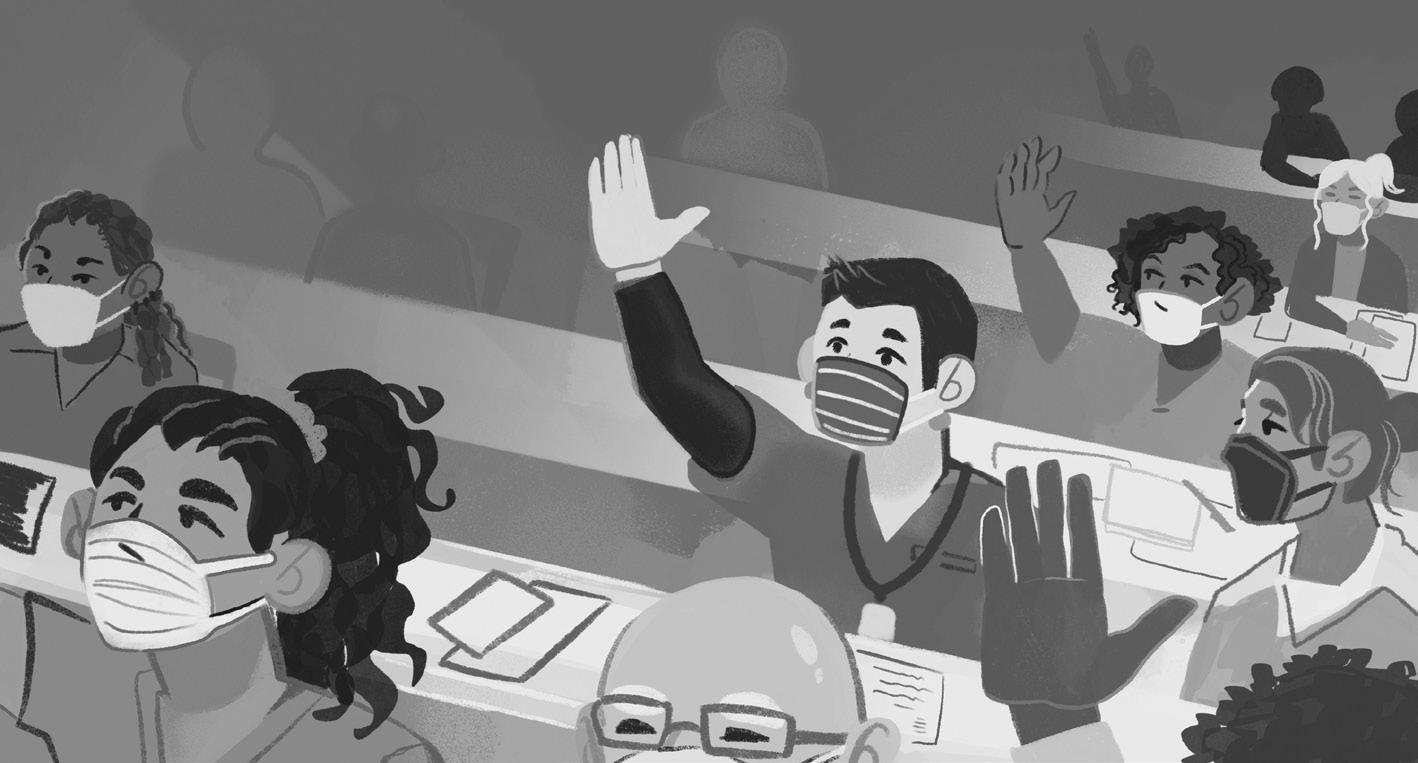 BY DOCUMENTERS AND SCOTT PEMBERTON
BY DOCUMENTERS AND SCOTT PEMBERTON
During its brief meeting, the City Council deferred major 2023 budget items to November 7, the Council’s next meeting. A public commenter marred the meeting with an anti-semitic remark, which was denounced by Alderwoman Debra Silverstein. Mayor Lightfoot directed the clerk to add a statement of values to the public comment instructions for speakers, and to cut the microphones for such speakers in the future. The Council passed a resolution naming November 2022 as Native American Heritage Month in Chicago, and a group of young public commenters spoke on the concept of Afro-Indigenous identity and the need for the inclusion of modern descendants of enslaved people in the concept of Indigeneity. The Council approved a resolution urging the Illinois General Assembly to make central voting sites a permanent fixture of Chicago’s elections, before appointing Sandra Blakemore as Commissioner of the Department of Assets, Information, and Services. The relatively new department supports City operations and services, and was formed as a cost-saving measure through the consolidation of two other departments in the City’s 2020 budget.
A months-long budgeting process culminated at this meeting as the City Council passed the City’s 2023 budget. Some Council members expressed disappointment at what they believed were underfunded opportunities to address homelessness and violence in the city. “I do not think this budget addresses gun violence in a sophisticated way,” said Alderwoman Sophia King (4th Ward), who has mounted a campaign for mayor. Alderman Thomas Tunney (44th Ward) said, “Whether it is the North Side or the West Side, people do not go out at night anymore.” He emphasized that his constituents do not feel safe and that morale among police officers serving his ward is low. Other Council members were more optimistic about mental health funding, which has increased to $89 million in 2022 from $12 million in 2019. In that year, 3,200 people received mental health services .75,000 are projected to be served in 2023. Alderman James Cappleman (46th Ward) noted that all of Chicago’s seventyseven neighborhoods are slated to have a mental health center by the end of 2022.
The Cook County Land Bank Authority (CCLBA) Land Transactions Committee approved several projects at its meeting, including an additional factory kitchen for the Pintaito Gourmet restaurant, a land agreement to restore and develop abandoned
property, and a resolution to further develop the Underground Railroad historical landmark along the Little Calumet River, which the Weekly has reported on. That development covers preservation efforts, more agricultural development, and the addition of a community bike center. Chicago housing and building agencies, along with their partners, are working to restore unused or dilapidated properties in uncertain economic conditions.
A special City Council meeting called to consider the Bring Home Chicago ordinance fell flat due to a lack of quorum. A revised proposal would put a referendum question on the February 2023 ballot asking voters if the Real Estate Transfer Tax on transactions over $1 million should be increased to create a dedicated revenue stream for homelessness services and affordable housing. After several quorum calls and recesses, the meeting was adjourned with no action being taken. Nineteen Council members attended the first meeting, a number that grew to twenty-five after a recess, but this was not enough to continue the meeting.
At its meeting, the City Council Committee on Finance passed fifteen items offered by the City Departments of Housing, Planning and Development, and Law. The items passed despite committee members’ dissatisfaction with some presenters’ lack of preparation, and confusion over the details of Tax Increment Financing (TIF) funding. An observer referred to the dissatisfaction as “general hostility” toward some presenters. Among the measures passed were authorization for the City to enter into an agreement with a developer for seventy senior housing units at 9633 South Cottage Grove Avenue. Another was a recommendation to enter into an agreement with Yellow Banana, LLC, which would utilize TIF assistance to acquire, rehabilitate, and operate six full-service grocery stores serving five wards on the South and West Sides. Some committee members raised concerns that preliminary plans were drawn up without adequate consultation with the members and their communities.
At its meeting, the City Council Committee on Housing and Real Estate heard more about Northwestern Medicine’s plans for a 120,000-square-foot advanced outpatient care center on the 4800 block of South Cottage Grove Avenue. Construction could begin in summer 2023 with completion two years later. A few of the economic and community benefits include a $130 million investment, a thousand or more construction jobs, 130 permanent employment positions, and 7,500 square feet of community space. Northwestern is committed to meeting the City’s policy goals for Minority and Women-Owned Business Enterprises (M/WBE) and the fifty percent residency requirement for hiring. Concern was raised about overlapping of services with the nearby University of Chicago medical facilities. A Northwestern representative said that both providers discussed services and that the new facility will plug a “big gap in care” in the area. He also said that it “will not hinder any of their services. We think it’s additive for the community.” The committee voted to recommend the plan be brought to a full council vote.
At the Chicago Park District Board of Commissioners meeting, a proposed budget plan for 2023 included reengaging After School Matters as a way to hire more lifeguards for the summer and boost hiring for other positions. Large music festivals like Lollapalooza and Riot Fest that are hosted in the parks will now have to seek event permit approval from the Chicago Park District Board of Commissioners, following months of pushback from Douglass Park-adjacent communities, as reported by the Weekly and others.
This information was collected and curated by the Weekly in large part using reporting from City Bureau’s Documenters at documenters.org.
Harris (Harriet) Park, 6200 S. Drexel Ave. Friday, December 2–Saturday, December 3, 11am–7pm. Free. bit.ly/PreKwanzaaMarketplace
African International House will be hosting their annual marketplace event at Harriet Harris Park. Kwanzaa is a celebration that strives to unify families and communities guided by seven principles. This year, they will honor the fourth principle, “Ujamaa-cooperative economics” which addresses the

interconnectedness and importance of working together as a people to achieve economic growth and self-reliance.


Enjoy the chance to purchase holiday gifts from Black-owned businesses, a free jazz performance from vocalist Maggie Brown, saxophonist Al Smith & Intimate Contact; and drum with the African Festival of the Arts Drum Village. There will be shopping, food, workshops, line dancing; and more. Friday includes deals as part of “Senior Day.” (Zoe Pharo)



WJI Reclamation Center, 2150 S. Canalport,
Suite 4A-1. Saturday, December 3, 9:45am–1:15pm. Free. bit.ly/WJIReclamationCircle
The WJI reclamation circles aim to bring women together in powerful ways to share and heal, reclaim their lives, build out your community and network and connect with meaningful resources. Circles run two and a half hours each and conclude with a 30-minute reception where participants can connect with service providers and peer-led resources led by-and-for women whose lives have been impacted by the criminal legal system. Food and refreshments will be provided and the space is child-friendly if moms should want to bring their children. (Zoe Pharo)
Harper Court, 5235 S. Harper Court. Saturday, December 3, 10am–6pm. Free. bit. ly/hydeparkhollyday
Join the University of Chicago, Downtown Hyde Park, the South East Chicago Commission and the Hyde Park Chamber of Commerce to celebrate Hyde Park Holly Day, a free holidaythemed event with outdoor activities in the neighborhood. The docket this year includes an ice sculpture stroll on 53rd Street and an ice carving demonstration at Harper Court. Soul Santa and Mrs. Claus, Buddy the Elf and live reindeer will be in

attendance. (Zoe Pharo)
2156 N. Tripp Ave. Monday, December 5, 5:30pm. Free. bit.ly/WaltDisneyBday
Celebrate Walt’s 121st birthday with his 9th annual birthday celebration at his birthplace home in Hermosa. The program features a children’s choir, holiday treats, and candle lighting ceremony and holiday songs sung by the Nixon Elementary students. (Zoe Pharo)
Various dates and locations (see above). Thursday, December 8–Friday, December 23. Free. bit.ly/ParkDistrictxmas
The Park District is hosting a series of community events themed around Christmas 2022. The “Modern Version of Christmas Carol Ellis Park Seniors” on December 8 from 11:30am to 12:30pm at 3250 S. Cottage Grove Ave.; “Miracle on 44th Street” on December 16 from 3pm to 6pm at 4434 S. Lake Park Ave.; the Annual Christmas Party on December 17 from 6pm to 9pm at 331 W. 45th St.; and a Christmas Toy Giveaway on December 23rd from 4:30pm to 6pm at 3858 S. Cottage Grove Ave. (Zoe Pharo)
South Asia Institute (SAI), 1925 S. Michigan Ave. Friday, December 9, 5pm–9:30pm. 12. bit.ly/SASMAgentsofChange
The South Asian Solidarity Movement is holding their first Holiday Giveback Workshop at the South Asia Institute to support three nonprofit organizations making an impact in Chicago. SASM is bringing together a diverse groups for an interactive evening of art, sharing food and drink, and critically discussing what it means to develop BIPOC Chicagoans as agents of change to increase inclusion and advance social impact in our communities.
The event will also coincide with the closing day of Prithika Chowdary’s exhibition, “Unbearable Memories, Unspeakable Histories,” which explores the post-colonial impact of partition on South Asians and how this has perpetuated division in the subcontinent. (Zoe Pharo)
The Promontory, 5311 S. Lake Park Ave. W. Thursday, December 15, 6pm–9pm. Tickets are $10. bit.ly/GrownFolksStories12
Celebrate the 12 year anniversary of Grown Folks Stories, which is a raucous two hours of five-minute stories ranging from hilarious to the absolutely real. A group of nonprofessional, unrehearsed storytellers take the stage and deliver real stories we live everyday. There is no theme, no judging, no poetry and no readings. Taking place every third Thursday of the month, this is the twelfth anniversary of this gathering. Created by Cara Brigandi and Eric Williams, founder of the Silver Room, and hosted by Binkey. Guest storyteller to be announced. (Zoe Pharo)
Richard J Daley Library, 3400 S. Halsted St. Friday, December 2, 10:30am–11:30am. Free. bit.ly/3gLNIN9
Join us for a screening of Secrets of the Dead: China's Terracotta Warriors. The extraordinary story of China's 8,000 terracotta warriors begins two centuries before the birth of Christ. The First Emperor of China was preparing an extravagant tomb for his journey into the afterlife and decreed that he be protected forever by a monumental army. Since then, no one has seen these ancient warriors in their original splendor, brightly painted and fully armed, ready to protect their Emperor for all eternity. Now this once
mighty army will be returned to its former glory for the first time. Row upon row of life-size, lavishly painted warriors will rise from the dust of two millennia. But how was a terracotta army of this size made in less than two years using the technology of 2,200 years ago? (Richard J Daley Library)
Healthy Minds Youth Mental Health Forum and Fair
Blue Door Neighborhood Center, 11840 S. Marshfield Ave. Saturday, December 3, 11am–2pm. Free. bit.ly/healthymindsfair
Run by youth, and for youth, is a Mental Health Resource Forum and Fair on Chicago’s South Side. For ages 16 to 24, youth attendees will hear from speakers on a variety of topics around mental health, including: how youth should take care of their mental health, understanding and managing anxiety, understanding and dealing with depression and managing stress as a young person. The event is sponsored by the National Youth Employment Coalition. Free food and parking is available. (Zoe Pharo)
Richard J. Daley Library Branch, 3400 S. Halsted St. Tuesday, December 6, 3:30pm–4:30pm. Free. www.chipublib.org
Attendees can make tornadoes and clouds in jars! Come experiment and learn about science. Make slime and other messy and fun things. Suggested for kids ages 7+.
1111 S. Homan Ave. Thursday, December 8, 6:30pm–8:30pm. Free with donation. bit.ly/ NLENLiveRecording
North Lawndale Employment Network will host a live recording of their podcast, “77 Flavors of Chicago,” dedicated to Chicago’s local flavors. Join them for an exciting conversation about food on the
West Side of Chicago. Your donation to NLEN secures your ticket to an evening of food (courtesy of Braid and Firehouse catering), drinks, music and community. (Zoe Pharo)

Conversation with Diana Solís
Poetry Foundation, 61 W. Superior Street. Thursday, December 1, 7pm–8pm. Free. bit. ly/DianeSolisEncuentros
This event will be a conversation between Diana Solís and Chicago exhibition curators Oscar Arriola and Nicole Marroquin about individual works in the exhibition. The exhibit “Diana Solís: Encuentros” presents photographs by queer Mexicana Chicana feminist artist Diana Solís documenting poetry communities in Chicago—including the Guild Complex, La Decima Musa, Weeds and Hothouse—throughout the 1970s through the 1990s. The exhibition features books, photographs and ephemera that explore this unique moment in Chicago’s literary history, illuminating the legacy of Solís’s life in arts and literature. Solis’ work is often inspired by Mexican and Chicago culture, memory, cautionary tales, oral and personal histories, queer identities and narratives; and examines notions of place, identity and longing. Be prepared to wear a mask, and to show proof of vaccination and ID. (Zoe Pharo)
Richard J. Daley Library Branch, 3400 S. Halsted St. Tuesday, December 6, 1pm–2:30pm. Free. www.chipublib.org
Muddy Waters’ Grammy-winning lyricist shares his tales of our hometown music and its roots as America’s first voice of protest. Muddy, Howlin’ Wolf, the Stones and the Gods of Rock & Roll come alive through Chicago native Terry Abrahamson’s rare photos, videos, stories and books, in a fun-filled celebration of the music that changed the world, and of
DuSable Black History Museum, 740 E. 56th St. Tuesday, December 6, 7:30pm–9pm. Free. bit.ly/SouthSidepremiere
The DuSable Museum will be holding an advance screening of the season three premiere episodes of HBO Max’s South Side, followed by an intimated conversations with the series’ co-creators Bashir Salahuddin and Diallo Riddle, moderates by WBEZ’s Reset’s host SashaAnn Simons. The new season premieres this December, and its characters and scenes focus on life on the South Side. (Zoe Pharo)



Haymarket House, 800 W. Buena Ave. Wednesday, December 7, 6:30pm–8pm. Tickets range from $0-25. bit.ly/ supersadblackgirl
Haymarket Books is holding an in-person launch event for Diamond Sharp’s “Super Sad Black Girl” with special guests Eve Ewing, Raych Jackson and Jamila Woods. Sharp’s newest book of poetry is “a love letter to her hometown of Chicago,” where she finds solace and community in her literary idols, and asks “What does it look like when Black women are free?” Lorraine Hansberry and Gwendolyn Brooks appear throughout these poems, counseling the speaking as she navigates her own depression and exploratory questions about the “Other Side,” as do Sandra Bland, Rekia Boyd and other Black women who have been murdered by police. Book signing and reception will follow. Masks and proof of vaccination are required for all attendees. (Zoe Pharo)
Montgomery Place, 5550 S. Shore Dr. Friday, December 9, 12pm. Free. bit.ly/ HPSoundsGoodChoirConcert
setting of a medieval text by Norwegian composer Ola Gjeilo and “A Midwinter’s Carol,” named after the famous poem “In the Bleak Midwinter” by Christina Rossetti, with new music by Houstonbased contemporary composer Victor C. Johnson. (Zoe Pharo)
The Quarry, 2423 E. 75th Street. Friday, December 9, 6pm–9pm. Tickets $20 at the door; $15 in advance. bit.ly/ FNLSamSomebody
In honor of one of the founders of smooth jazz, saxophonist Grover Washington Jr., recording artist Sam Somebody (as seen on The Jimmy Kimmel Show and Conan O’Brien Show) will play at the Quarry. Come for live music, food and drink and dancing at “the Jewel of South Shore.” (Zoe Pharo)
The Kehrein Center for the Arts, 5628 W. Washington Blvd. Monday, December 12, 6pm–9pm. Free. bit.ly/xmasfamilymusical



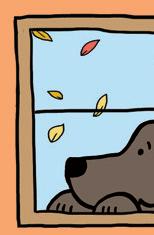
This Christmas-centric Chicago West Side family musical and dinner will showcase the talents of local youth and adults through skits, dancing, singing, videos and music. Special performing guests include the Chicago Multi-Cultural Center for the Arts and the Hiplet Ballerinas. (Zoe Pharo)






Jazz Showcase, 806 S. Plymouth Court. Monday, December 12, 7pm–9pm. Tickets are $50 for general admission and $75 for VIP seats. bit.ly/holidayrhythms2022


The Chicago Human Rhythm Project celebrates the season at the historic Jazz
on piano and Jumaane Taylor on taps. Special guests include vocalist Amyna Love, Stone Soup Rhythms and more. This joyful performance will marry tap dance with live jazz music at the best jazz venue in the South Loop, with all proceeds benefiting CHRP’s Mayfair Arts Center, a new South Side arts incubator-educator space. (Zoe Pharo)
Overflow After Dark with B. Lilly and Alysha Monique
Overflow Coffee, 1449 S. Michigan Ave.
music experience fusing blues, soul and jazz over time, provides local artists and entrepreneurs with a professional platform to showcase their work. Hosted at Overflow Coffee, the former home of VeeJay Records, Chicago artists B. Lilly Music and Alysha Monique will perform. Lilly was born and raised in Chicago’s West Side community in Austin, and has a style that has been described as “a refreshing fusion of rhythm and blues, gospel, jazz, and hip hop.” Monique has a sultry vocal styling that mixes jazz and soul music. (Zoe Pharo)


